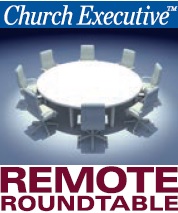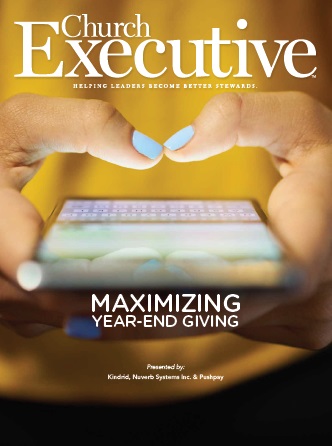Strategies for using technology to encourage giving all year round

President
Nuverb Systems Inc.
 Define ‘year-end giving.’ What months of the year are we referring to?
Define ‘year-end giving.’ What months of the year are we referring to?
B. Louie Cordovado: Year-end giving refers to giving during the last two to three months of a church’s fiscal year — usually October to December.
Kacie Frazier: Year-end giving is the most charitable time of year when churches see generosity at its peak. Often referred to as the “season of generosity,” year-end giving kicks off in November on the National Day of Giving (#GivingTuesday) and runs through the entire month of December.
Troy Pollock: For most churches, year-end giving is considered October through the end of December.
How important is year-end giving in most churches?

Church Success Lead
Kindrid
Frazier: Year-end giving is crucial for churches because it allows them to close out the year on
budget and provides a nice boost in finances to start the new year. In 2018, December accounted for 17% of overall giving to churches, and a good portion of that happened in the last three days of the year.
Pollock: While the holiday season welcomes a time of family, community, celebration and traditions, year-end can also be stressful as it’s the last big push to hit budget numbers and encourage gifts to help sustain and grow ministry efforts. In fact, a large percentage of annual giving occurs in December, with nearly 10% occurring on the last three days of the year, specifically.
Beyond giving, year-end is also a great opportunity for pastors to thank donors and connect with their community in a meaningful way.

Chief Ambassador
Pushpay
Cordovado: Year-end giving shouldn’t be as important as giving throughout the entire year. Having to encourage people to donate at the end of the year, means a church hasn’t created an attitude of generosity the rest of the year. Sadly, most churches don’t do this, so they’re ‘forced’ to try to catch up near year-end. So, for most churches, year-end giving is important because they need it to meet their budget.
What are the most common challenges related to year-end giving in churches?
Pollock: Churches put a lot of pressure on reaching a budget number the last few months of the year and oftentimes forget to share and show how gifts and participation are helping impact the lives of others. In fact, a lot of churches struggle to engage with their communities in general. We know there’s a huge gap between those who are active participants (the roughly 20% who are giving their time and resources) and the average member (the roughly 80% of attendees who’d like to be more involved but aren’t sure how to engage). Recent research shows that more than 90% of people who serve also give, so we know that closing the participation gap naturally drives generosity.
What if churches focused more on nurturing their communities throughout the entire year, in order to ease the pinch/pressure on the EOY giving season?
Cordovado: One challenge is to encourage giving without giving the wrong impression (i.e., that the church is always asking for money). Another challenge is getting the technology in place before year-end.

Frazier: Some churches struggle to talk about money, even during year-end when people are feeling most generous. Others simply don’t have time to focus as heavily on year-end gifts because there are so many activities competing for attention.
One of the biggest challenges is that churches wait too long to begin discussing and strategizing about year-end giving. While year-end gifts naturally boost church finances, with a strategic plan to promote it and the right digital giving tools in place, giving could increase even more.
The best way to combat these challenges is to have a plan and implement it sooner rather than later — we’re talking September or even earlier!
Compared to more traditional giving options, in what ways can technology uniquely inspire giving during a church’s year-end worship services and Christmas events?
Cordovado: Technology is only part of the answer — it will make giving easier and help you manage it but not motivate members to give in the first place. Churches need to instill a sense of mission and purpose, and get people to want to participate in the work of the Creator of the universe — in spreading the good news of Jesus Christ.
Frazier: Technology is a fantastic way to inspire year-end giving because people are using it to celebrate the season. Most people already pull out their phone during church to access their Bible app or take pictures during the Christmas play. Giving via text or online is literally at their fingertips!
With digital giving, churches can also create a special year-end fund for givers to choose. When people see the gift is unique from normal giving, they might be inspired to contribute a little more than usual.
Pollock: Many churches saw nearly a 10-percent decline in year-end giving last year. I think technology not only enables digital giving, but empowers churches to share great news about upcoming campaigns and initiatives that are helping the community. People are inspired when they see how their gift is impacting the lives of others. Leverage it to tell a story — whether that’s through personal communication in an app or email, or sharing a video on social media.
Is it fair to say that technology can drive more generous giving (versus traditional giving options) at year’s end? If so, why?
Frazier: Absolutely! People are more generous during year-end, but that doesn’t mean they carry more cash on them or remember to throw a check in their wallet. If they’re inspired to give the church $100, but they only have $40 cash on them, they’ll simply give less if it’s the only option.
With online, text and app giving options, people can donate as much as they want. Plus, they aren’t limited to giving in church during the offering. They can give any day and time of the week. If they prefer to give when balancing their own budget at home in front of the computer, they can. It’s whatever’s most convenient for them.
Pollock: Technology can absolutely drive more generosity. In fact, those who give digitally are simply more generous. We know that, on average, digital givers donate 33% more than non-digital givers and that they’re eight times more likely to give to multiple initiatives within their church. Providing a convenient, seamless way for people to contribute will increase the volume of gifts.
In addition, initiating separate campaigns for specific ministry efforts or year-end community needs oftentimes inspires people to give on top of their regular tithe.
Cordovado: Technology can help with giving the whole year — see next question.
In what ways can churches use technology at year’s end to encourage long-term giving throughout the year, or sustained giving — in effect, lessening a church’s dependence on year-end giving?
Pollock: Did you know that only 27% of digital giving actually happens on Sunday? That means 73% of digital giving happens Monday through Saturday. A big part of that is because of recurring gifts.
Whether your team decides to default to recurring giving within the app or focuses on communicating the value of recurring gifts during Sunday services, providing a digital way to manage recurring tithes enables you to better forecast funds throughout the year, not just during the holiday season.
Cordovado: To encourage long-term giving throughout the year, technology can help in these ways:
Asking members to pledge a certain amount increases giving. The best way is to ask each member to prayerfully consider how God has gifted them with their time, talents and treasures and to explore in prayer how much God is calling them to commit to the church. On average, members will give 4.6% of their income, while just asking them how much they will give, results in giving 2.9% of their income. Without pledges, members donate only 1.5%.
Technology can help to manage pledges, by: including pledge info on quarterly statements or other reports so that members are reminded of what they committed; thanking those who have fulfilled their pledges; and encouraging those who are falling short on their pledges.
Technology can facilitate communication with your members. For example, showing appreciation for giving, such as when a new member makes their first contribution. It can also inform members of how their giving is fulfilling the mission of the church. When they see what their giving is accomplishing, they are encouraged to continue giving.
People want to give, but they need practical help in managing their finances. Technology can’t help much with that, but it can make it easier for them to give and be consistent in their giving in the following ways:
- The majority of people don’t carry cash or checks, so install a giving kiosk. Also set up text-to-give so they can give on their cellphones.
- Set up online and pre-authorized giving (EFT or ACH) so people give consistently. This will prevent a decline in the summer. It also means that if someone can’t make to a service, they can still give.
- Use offering envelopes with the date of each Sunday marked on each envelope. People then know if they have missed a week.
Frazier: When you create a giving page with Kindrid, whether for general giving or a special fund, a “Make this Gift Recurring” box is visible and easy to check. Recurring gifts are deducted automatically and incredibly easy to set up.
Without even mentioning this option, many of our churches see givers sign up for it. Just having the option available on your website and giving pages can make a huge difference in sustained giving.
If anyone wants to dig a little deeper into encouraging long-term giving, they can grab our free 2019 Year-End Bundle with a video and 15-page strategy guide.


